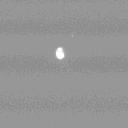Pallene (moon)

Pallene in September 2010
|
|
| Discovery | |
|---|---|
| Discovered by |
Voyager 2 (first discovery) Cassini Imaging Team |
| Discovery date | June 1, 2004 (second discovery by Cassini-Huygens) |
| Designations | |
| Saturn XXXIII S/1981 S 14 (first discovery) S/2004 S 2 (second discovery) |
|
| Orbital characteristics | |
| Epoch 20 June, 2004 (JD 2453177.5) | |
| 212,280 ± 5 km | |
| Eccentricity | 0.0040 |
| 1.153745829 d | |
| Inclination | 0.1810 ± 0.0014° (to Saturn's equator) |
| Satellite of | Saturn |
| Physical characteristics | |
| Dimensions | 5.76 × 4.16 × 3.68±0.14 |
|
Mean radius
|
2.22±0.07 km |
|
Mean density
|
0.25+0.09 −0.06 g/cm3 |
| synchronous | |
| zero | |
Pallene (/pəˈliːniː/ pə-LEE-nee; Greek: Παλλήνη) is a very small natural satellite of Saturn. It is one of three small moons known as the Alkyonides that lie between the orbits of the larger Mimas and Enceladus. It is also designated as Saturn XXXIII (33).
Pallene was discovered by the Cassini Imaging Team in 2004, during the Cassini–Huygens mission. It was given the temporary designation S/2004 S 2. In 2005, the name Pallene was provisionally approved by the IAU Division III Working Group for Planetary System Nomenclature, and was ratified at the IAU General Assembly in 2006. The name refers to Pallene, one of the Alkyonides, the seven beautiful daughters of the giant Alkyoneus.
After the discovery in 2004, it was realized that Pallene had been first photographed on August 23, 1981, by the space probe Voyager 2. It had appeared in a single photograph and had been provisionally named S/1981 S 14 and estimated to orbit 200,000 km from Saturn. Because it had not been visible in other images, it had not been possible to compute its orbit at the time, but recent comparisons have shown it to match Pallene's orbit.
...
Wikipedia
